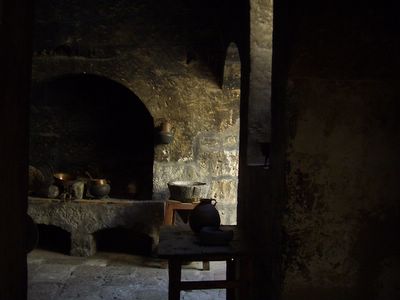Diane: As soon as we arrived in the center of Arequipa, I could tell that we would be comfortable here. Since Tom needs to fully recover from his sinus infection and Calliope seems to have contracted another full-blown case of tonsillitis, I decided to find accommodations that we would really enjoy. The rest of the family waited patiently, and then expectantly, and then worriedly as I tracked down the perfect-for-us Colonial House Inn. After a round of complaints, I was inundated with gratitude at this wonderful find.
It is made from sillar, the white volcanic stone from which the majority of the buildings here are made, including the elaborate archways and facades of the finer mansions and churches. The walls of our room are about a meter thick, maybe thicker. The rounded ceiling has a small opening to light the interior. As the sky brightens early in the morning, it shines on my bed. As the hours of the day go by, each area of the room brightens as the light reaches there. We also have glaring fluorescent lights, when natural light is insufficient. Our window looks out on the interior courtyard, which even has a fig tree with some mature fruit hanging from it. Upstairs, the rooftop dining area is surrounded by potted plants. There is an exchange library of English-language books and common areas where the kids can watch TV, cook, do laundry, etc.
Our first meal in Arequipa was in a restaurant that appeared to be the exact same dimensions as our room, made from sillar with rounded ceiling, just as our room is. At first I thought it was the stock size of all sillar rooms in Arequipa. As it turns out, many rooms are long and low to the ground to prevent earthquake damage.
Having now visited a couple of universities and cultural centers made of the lovely sillar, I can say that no building quite captures the heart and soul of this architectural style as the Santa Catalina convent. We took a family outing there today, to visit the city within the city center of Arequipa. It was a cloistered convent for 400 years, until 1985, housing daughters from many wealthy families. Since 1985, the remaining nuns have been half-cloistered. The buildings have sustained significant earthquake damage over the years, but most were restored in the 1980's, and the nuns now live off the convent entry fees. The sillar is everywhere as are the cobblestone/river-rock streets and lovely archways that lead from one tranquil space to the next.



The woodwork on the doors as well as the solid columns both add to the safe and solid feel of the place.

Even the roof lines are lovely. You can see where rainwater would come off the rooftops. There are well-organized stone gutters running in the streets as well to catch this falling water.
This was not a communitarian convent. I'd estimate that we saw at least 50 kitchens. Each kitchen had been well-used as evidenced by the grimy black ceilings.


A couple of centuries ago, after a visit from the archbishop, an order came down to limit each nun to one servant. This order met with such disapproval and organized resistance, that the final result was the resignation of the archbishop.
The only reason our room at the Colonial House Inn is not as tranquil as the convent is that WE are living there. Once we leave, it should take on the same serene air we encountered at the convent. Until that time, only the ceiling truly reflects the spirit of our room.

No comments:
Post a Comment